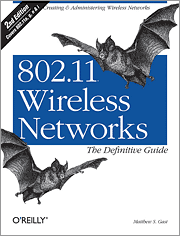
Title: 802.11 Wireless Networks: The Definitive Guide (Second Edition)
Author: Matthew S. Gast
Price: £31.95
Publisher: O’Reilly
Published: April 2005
Reviewed by: Martin Ward
Review Date: December 2005
Rating: 5/5
Calling your book “The Definitive Guide” sets the bar high at the start, and Gast does well to live up to his title and provide virtually everything you need to know about 802.11 networking.
If you are a wardriver looking for plans to make antennae out of Pringles cans, then you won’t find them here (but they are readily available on the Internet!) If you need to set up a wireless network of any size, or are just curious about how they actually work, then this is the book for you.
Book Layout
After an Introduction and Overview in Chapters 1 and 2, Chapter 3 looks at MAC (Media Access Controller) Fundamentals: everything between the device driver and the radio.
Chapter 4 describes frame layouts.
Chapter 5 discusses WEP (the so-called Wired Equivalent Privacy) and its many shortcomings.
Chapters 6 and 7 disciss 802.1X and 802.11i respectively.
Chapter 8 deals with management functions: scanning, preauthentication, association, power conserving etc.
Chapter 9 deals with PCF (Point Coordination Function), an as-yet unimplemented standard for contention-free access to the medium.
Chapters 10 to 14 deal with the physical aspects of RF propagation, frequency hopping and modulation techniques and so on.
Chapter 15 describes the competing proposed 802.11n standards, which will offer over 100Mbs of throughput over a wireless link.
Chapters 16 to 19 give detailed information on setting up wireless hardware and drivers on Windows Mac and Linux systems.
Chapters 20 and 21 discuss access points and the options for organising the logical wireless network architecture.
Chapter 22 discusses the important issue of the security architecture.
Chapter 23 describes site planning issues and some of the project management issues.
Chapters 24 and 25 look at network analysis and performance tuning.
Finally Chapter 26 concludes.
The book is very detailed and thorough, with a lot of useful information. There is some repetition: I lost count of the number of places where the reader is warned of the broken nature of static WEP security, for example! But this is probably inevitable in a book of this size and scope, when there is some attempt to make the various parts of the book self-contained.
Overall, “802.11 Wireless Networks: The Definitive Guide” lives up to its name and is highly recommended.
